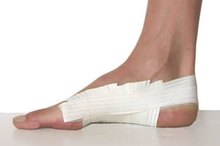Numbness in Toes When Exercising
Toe numbness during exercise is quite common, but that doesn't mean it's normal. It can be caused by something as simple as lacing your shoes too tight, or it could be a manifestation of a more serious condition that requires medical treatment. In most cases, toe numbness can be traced to improper equipment or technique, but if it continues after those things are fixed, it may be time to see a doctor.
If you are experiencing serious medical symptoms, seek emergency treatment immediately.
Check Your Shoes
You should wear sport-specific shoes that fit properly from day one. It is important that your foot be cushioned and supported correctly for your specific sport, or you will end up compressing nerves in the ball of your foot or in your heel, which can lead to numbness or tingling in the toes.
Don't lace your shoes as tight as they go -- as long as your heel doesn't slip out, they're tight enough. Too-tight lacing can restrict the blood flow to your feet, which can also cause numbness. It's a good idea to readjust the laces all the way up every time you put your shoes on.
Check Your Habits
What Causes Sore Feet in the Morning After Exercise
Learn More
If you run on concrete, the impact could be causing nerve damage in your foot that will lead to a loss of feeling in the toes. Try running on asphalt or grass instead. If you're a cyclist, pedaling with the ball of your foot over the pedal's axle can do the same. Slide your foot forward until your arch is over the axle to relieve the pressure. Rigid-soled cycling shoes will better support your foot.
If you walk or jog, make sure your foot completes a full roll-through on every stride. Whatever your activity of choice, all movement that originates in the foot should be comfortable and fluid. Also use the full range of motion.
More Serious Conditions
Toe numbness can also be the result of a condition that is unrelated to your workout, but may be aggravated by it. Peripheral neuropathy is pain from nerve damage caused by a number of conditions including trauma, infections and metabolic issues. It is usually treated with pain relievers and electrical nerve stimulation, but the underlying cause must be treated as well.
Peripheral artery disease is a hardening of the arteries in the legs which restricts the blood supply and causes numbness in the feet. The pain usually gets worse with exercise and subsides after resting for a while. Peripheral artery disease is treated with lifestyle adjustments, blood thinners, cholesterol medication and pain relievers, but surgery may be necessary in extreme cases.
When to See a Doctor
My Foot Falls Asleep During Exercise
Learn More
Consult your doctor if new shoes and a technique adjustment don't seem to help. If the numbness is accompanied by chest pains and a shortness of breath, seek emergency medical attention. If your feet become discolored or are a different temperature than the rest of your body or if you are experiencing signs of infection, visit your doctor for a formal diagnosis.
Related Articles
References
Writer Bio
Angela Brady has been writing since 1997. Currently transitioning to a research career in oncolytic virology, she has won awards for her work related to genomics, proteomics, and biotechnology. She is also an authority on sustainable design, having studied, practiced and written extensively on the subject.








